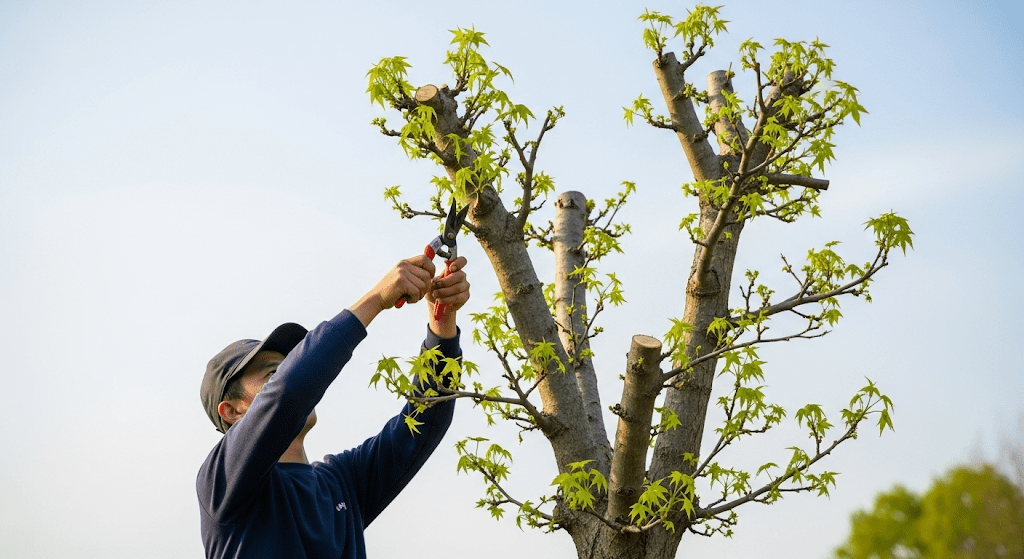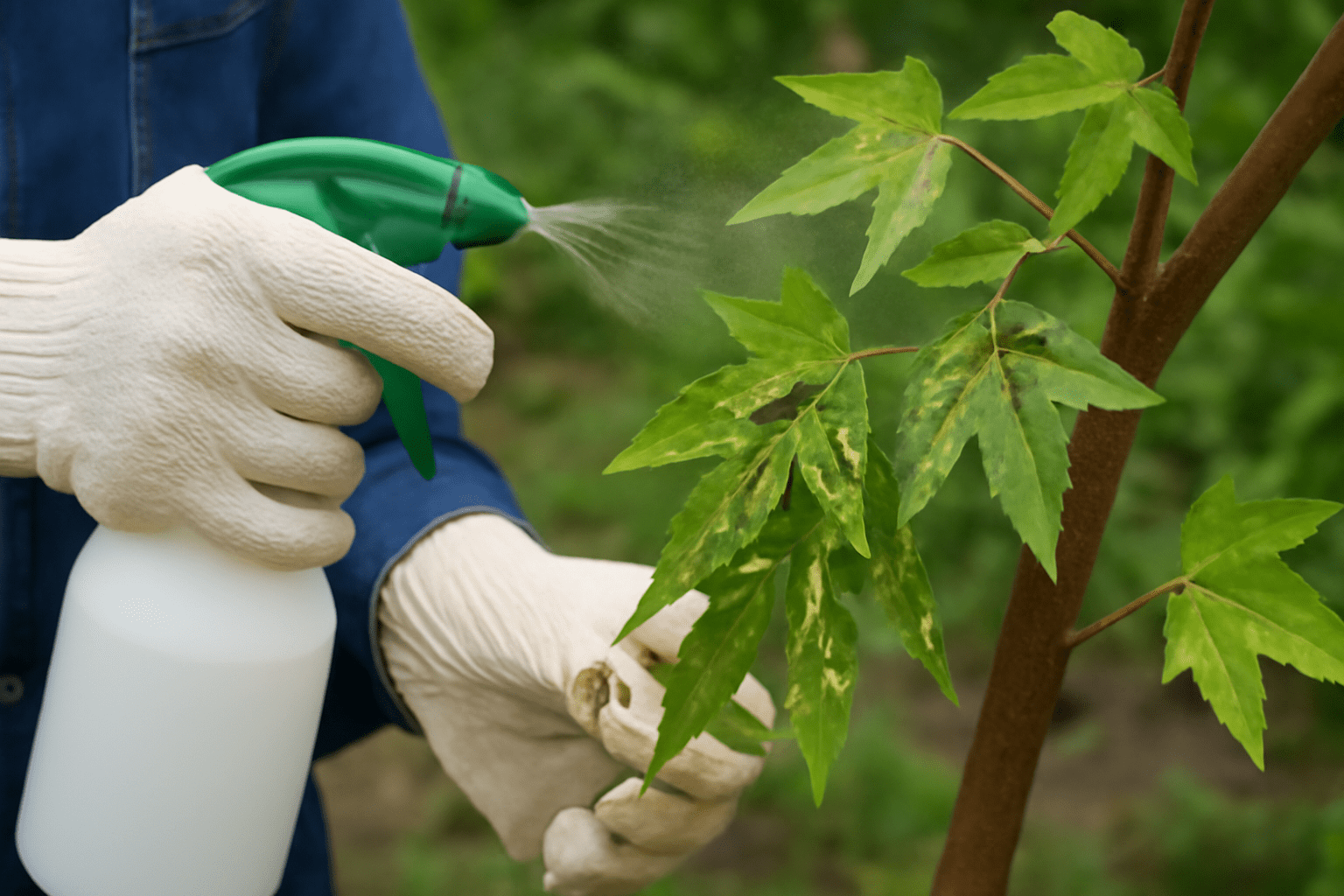
Chinese Sweetgum: Expert Tips for Growing, Caring, and Troubleshooting Common Problems
Table of Contents
Toggle🌳✨ The Benefits of Growing Chinese Sweetgum ✨🌳
If you’re considering adding a tree to your garden, the Chinese Sweetgum offers a range of benefits that can transform your outdoor space. Here’s why this tree is an excellent choice for your yard:
🌟 1. Beautiful Foliage and Stunning Fall Colors 🍁
One of the main attractions of the Chinese Sweetgum is its striking appearance. During spring and summer, its star-shaped leaves are a deep green 🌿. But it’s in autumn 🍂 when this tree really shines, transforming into a vibrant display of reds, oranges, and yellows 🌅. It’s a real showstopper 🌟 that adds a touch of seasonal beauty to your landscape year after year.🦋 2. Low Maintenance and Easy to Grow 🌱
Chinese Sweetgum trees are relatively low-maintenance once established 🌱. They don’t require constant attention or expert care 👩🌾. With a little initial planting effort and regular watering 💧, they grow strong and healthy 💪 with minimal intervention. This makes them perfect for both beginner gardeners and busy homeowners who want a beautiful tree without the stress of constant upkeep 🕒.🐦 3. Attracts Wildlife 🌼
These trees don’t just look good—they also contribute to the ecosystem 🌍. The Chinese Sweetgum provides shelter for birds 🦜, insects 🐞, and other wildlife 🦋. During the fall 🍁, birds often use the tree for nesting 🏡, while the seeds can serve as food for wildlife 🌰. If you’re a nature lover 💚, this tree will attract beneficial creatures 🐾 to your garden, creating a more vibrant, sustainable environment 🌳.🌱 4. Versatility for Landscaping 🏡
The Chinese Sweetgum is versatile in landscape design 🌿. Whether you’re planting it in a large yard 🏡, along streets 🚶♂️, or as a focal point in a garden 🌺, its symmetrical shape and year-round beauty make it an ideal choice. It’s also a great tree to create a focal point in your garden 🌼 or provide shade 🌞 during the summer.🌿 5. Disease and Pest Resistant 🐞
Another great benefit of the Chinese Sweetgum is its resistance to many common tree pests 🐜 and diseases 💀. While no tree is entirely immune 🛡️, this species generally requires fewer treatments than others 🌱, making it a relatively hassle-free addition to your garden 🌳. In summary, the Chinese Sweetgum tree brings beauty 🌸, wildlife support 🦋, and ease of care 🌱 to your landscape. Whether you’re seeking a tree for aesthetic value 🌻, low-maintenance care 🛠️, or eco-friendly benefits 🌍, this tree delivers it all with style! 🌳💚🌱🌳 How to Grow Chinese Sweetgum 🌳🌱
Growing a Chinese Sweetgum tree is a rewarding experience, especially when you see it flourish with vibrant leaves and strong growth 🌿. Here’s everything you need to know to successfully plant and nurture your tree 🌳:
🏡 1. Choosing the Right Location 🏡
The first step to growing a healthy Chinese Sweetgum is selecting the perfect spot for it to thrive 🌟:- 🌞 Sunlight: These trees love the sun! 🌞 Plant your Chinese Sweetgum in an area that receives full sun for at least 6 hours a day to encourage strong growth and colorful foliage 🍃.
- 🏠 Space: Chinese Sweetgum trees can grow quite large, up to 40 feet tall and 30 feet wide 🌳. Make sure there’s enough space for it to spread out without obstruction.
- 🌍 Soil: They prefer well-drained, slightly acidic to neutral soil 🌱. Check the soil pH before planting, aiming for a pH between 5.5 and 7.0 ⚖️.
🌍 2. Planting Your Chinese Sweetgum Tree 🌍
Once you’ve found the perfect spot, it’s time to plant 🌱:- ⛏️ Dig a Hole: Dig a hole that’s twice as wide and the same depth as the root ball of your tree 🌳.
- 🌱 Place the Tree: Gently remove the tree from its pot and place it in the hole, ensuring the top of the root ball is level with the surrounding soil 🌾.
- 💧 Backfill and Water: Fill in the hole with a mixture of soil and compost 🌿. Water the tree deeply after planting to settle the soil and provide moisture to the roots 💦.
💧 3. Watering Your Chinese Sweetgum 💧
Water is crucial during the early stages of growth 💦:- 🌱 Young Trees: Keep the soil consistently moist for the first few months 🌱, watering deeply when the soil feels dry to the touch 💧.
- 🌳 Established Trees: Once your tree is established, it’s more drought-tolerant 🌞. Water it during dry spells to keep it healthy and encourage vibrant fall colors 🍂.

🌿 4. Pruning and Shaping 🌿
Pruning helps your Chinese Sweetgum grow strong and shapely 🌳:- 🌸 When to Prune: The best time to prune is in late winter or early spring before new growth starts 🌼.
- ✂️ What to Trim: Remove any dead, diseased, or crossing branches 🌿. This improves airflow and helps prevent disease while maintaining a clean, attractive shape 🌟.

🌳 5. Fertilizing 🌳
Chinese Sweetgum trees are not heavy feeders, but some occasional feeding can help them grow healthy and strong 🌱:- 🌷 Fertilize in Spring: Apply a balanced fertilizer (10-10-10) in early spring when the tree starts its growing season 🌞.
- ⚖️ Avoid Over-Fertilizing: Too much fertilizer can cause excessive growth at the expense of the tree’s health 🌱, so stick to a light feeding schedule 🌿.

📅 6. Ideal Planting Time 📅
For the best results 🌟, plant your Chinese Sweetgum tree in the early spring or fall 🍁. These seasons provide mild temperatures and allow the tree to establish itself before extreme weather conditions hit 🌬️.🌿💧 Essential Care Tips for Chinese Sweetgum 💧🌿
Caring for your Chinese Sweetgum tree is simple once you know the basics 🌱. Follow these essential care tips to ensure your tree remains healthy, vibrant, and pest-free all year long 🌳:🌱 1. Watering Your Chinese Sweetgum 🌱
Water is key to your tree’s success, especially in the early years 💧:- 🌿 Young Trees: Water deeply to ensure the root system establishes itself 🌳. Aim to water the tree every 1-2 weeks, depending on rainfall 🌧️, ensuring the soil remains consistently moist but not soggy.
- 🌳 Mature Trees: Once established, your Chinese Sweetgum becomes more drought-tolerant 🌞. However, it will benefit from occasional watering during dry spells 🌵. Water deeply during prolonged dry periods, especially in summer 🌞.
✂️ 2. Pruning and Shaping ✂️
Pruning helps maintain a strong structure and keeps the tree looking neat 🌿:- 🌸 When to Prune: Prune your Chinese Sweetgum during late winter or early spring when the tree is dormant 💤. This prevents stress on the tree and allows new growth to flourish in the spring 🌱.
- 🌿 What to Cut: Focus on removing dead, diseased, or damaged branches 🌳. Also, trim any branches that cross over each other to allow air to circulate through the canopy 🌬️. This helps reduce the risk of disease 🦠.
- 🌳 Shape the Tree: If you’re looking to shape the tree, focus on encouraging a central leader (main trunk) with evenly spaced branches to promote a strong, balanced structure 🌳.
🌿 3. Fertilizing Your Tree 🌿
Fertilizing ensures your tree gets the nutrients it needs to grow strong and healthy 🌱:- 🌸 Best Time to Fertilize: Apply a balanced fertilizer in early spring when the tree begins its growth cycle 🌞. A balanced fertilizer with equal parts nitrogen, phosphorus, and potassium (like 10-10-10) is ideal 🌿.
- ⚖️ Fertilizer Tips: Only fertilize once a year to avoid overfeeding 🚫. Too much fertilizer can cause excessive leaf growth at the expense of root and bark development, weakening the tree in the long term 🌱.
🌸 4. Mulching and Soil Care 🌸
Proper mulching helps retain moisture and protect the tree’s roots 🌳:- 🌱 Mulch Around the Base: Apply a 2-3 inch layer of mulch around the base of the tree 🌿, but make sure to keep the mulch away from the trunk to prevent rot 🪱.
- 🌱 Benefits of Mulching: Mulch helps regulate soil temperature 🌡️, retain moisture 💧, and prevent weeds from competing for nutrients 🌾. It also adds organic matter to the soil as it breaks down over time 🍂.
- 🌳 Soil Health: Chinese Sweetgum trees prefer well-draining, slightly acidic to neutral soil 🌱. To improve soil structure, consider adding compost or organic matter around the root zone 🌿.
🐞 5. Pest Control 🐞
While Chinese Sweetgum trees are relatively pest-resistant, it’s important to monitor for any potential issues 🐜:- 🐛 Common Pests: Aphids 🦗, scale insects 🐞, and caterpillars 🐛 can sometimes cause damage. Look for signs such as yellowing leaves 🍂 or sticky residue on the leaves (which indicates aphid activity 🐜).
- 🌿 How to Treat: Use insecticidal soap or neem oil 🌱 to treat pests organically. Always apply during cooler parts of the day to avoid harming beneficial insects 🦋.
- 🍂 Preventative Measures: Regularly inspect the tree for pests 🔍, especially in the spring and fall 🍁. Pruning damaged or infested branches early can prevent the spread of pests 🐜.

🌤️ 6. Protection from Extreme Weather 🌤️
While Chinese Sweetgum trees are hardy, protecting them from harsh conditions can promote better growth 🌳:- ❄️ Frost Protection: Young trees are sensitive to frost 🌬️. If frost is predicted in late spring, cover young trees with burlap or a frost cloth to protect the new growth 🌱.
- 🌪️ Wind Protection: If you live in a windy area 🌬️, provide some protection for the tree 🌳, especially during the first few years. Consider planting in a spot with natural windbreaks 🌿 or adding temporary supports.

🛠️🌿 Troubleshooting Common Problems with Chinese Sweetgum 🌿🛠️
While the Chinese Sweetgum is a generally hardy and low-maintenance tree 🌱, it can still face some common problems. If you’re experiencing issues with your tree, don’t worry! Here are some of the most frequent problems and how to fix them 🌳:🍃 1. Yellowing Leaves 🍃
Yellow leaves are a common issue with Chinese Sweetgum trees 🌿 and can be caused by a few factors:- 💧 Overwatering: Too much water can suffocate the roots, leading to yellow leaves 🍂. Ensure the soil drains well and doesn’t stay soggy 🌱.
- 🌿 Nutrient Deficiency: A lack of key nutrients, particularly nitrogen, can cause yellowing 🌿. Fertilize with a balanced fertilizer to help address the deficiency 🌱.
- 🌱 Poor Soil Drainage: If the soil doesn’t drain well, the roots can become waterlogged 💧. Improve drainage by adding compost or organic matter to the soil 🌾.

✅ Solution: ✅
Check your watering habits 💦 and consider testing the soil for nutrient levels to adjust accordingly 🌱.🐞 2. Pests and Insects 🐞
Chinese Sweetgum trees can attract various pests 🦗, including aphids, scale insects, and caterpillars 🐛. These pests can damage the leaves and stunt growth 🌳.- 🐜 Aphids: These tiny insects feed on the sap of the tree 🌿, leaving behind a sticky residue and causing yellowing or curled leaves 🍃.
- 🐞 Scale Insects: These pests create hard, shell-like coverings on the tree and can be found on the branches or leaves 🌿.
- 🦋 Caterpillars: Caterpillars may feed on the foliage 🌿, leaving holes or ragged edges in the leaves 🌱.
✅ Solution: ✅
To treat pests 🐜, use insecticidal soap or neem oil 🌱, applying it to the affected areas. Be sure to inspect the tree regularly 🔍, especially in the spring and fall 🍂.🍂 3. Leaf Spot and Fungal Diseases 🍂
If you notice dark spots on the leaves 🍃 or the edges turning brown, it might be due to a fungal infection or leaf spot disease 🌱. These conditions can thrive in humid climates 🌦️.- 🌿 Powdery Mildew: A white, powdery coating on the leaves 🍃 is a sign of powdery mildew, which thrives in warm, damp conditions 💧.
- 🍂 Leaf Spot: Brown or black spots on the leaves 🍃 are often caused by fungal infections, which are common in moist environments 💦.
✅ Solution: ✅
Ensure your tree has good air circulation by pruning overcrowded branches ✂️. Remove affected leaves 🍂 and treat the tree with a fungicide if necessary 🌿. Infected areas should be cleaned up promptly to prevent the spread of disease 🦠.🌱 4. Poor Growth or Stunted Development 🌱
If your Chinese Sweetgum is growing slowly or has stopped growing altogether 🌿, it could be due to a variety of issues:- 🌱 Poor Soil Conditions: The tree might not be getting the nutrients it needs 🥦. Test the soil 🧪 and amend it if necessary to ensure it’s slightly acidic to neutral with good drainage 🏡.
- 💧 Root Stress: Compacted soil or overwatering can damage the roots, preventing them from absorbing nutrients and water properly 💦.
✅ Solution: ✅
Consider improving the soil by adding organic matter 🌿, compost 🍂, or mulch 🌳. If your tree is young, ensure it is well-watered but not waterlogged 💧.🌳 5. Tree Falling Over or Weak Structure 🌳
If your tree seems to be leaning or weak 🏚️, it might be due to poor root development or an unstable trunk:- 🌱 Weak Roots: If the roots haven’t had time to properly establish 🌱, the tree may not have the strength to support its size 🌳.
- 🌬️ Heavy Winds: Chinese Sweetgum trees can sometimes suffer from wind damage 🌪️, especially when young 🌱.
✅ Solution: ✅
If your tree is young and leaning 🌱, stake it with bamboo poles 🏗️ or tree stakes 🌳 to keep it upright. Make sure to remove the stakes once the roots have stabilized 🌳. Additionally, ensure the tree is planted in well-drained, non-compacted soil 🏡 to support healthy root growth 🌿.💨 6. Leaf Drop and Early Fall Colors 💨
Premature leaf drop 🍂 or early fall colors 🍁 can be a sign of environmental stress or nutrient deficiencies:- 🌞 Environmental Stress: Extreme weather conditions 🌦️, such as drought 🌵, heatwaves 🌡️, or early frost ❄️, can cause the tree to lose its leaves prematurely 🍃.
- 🌱 Nutrient Imbalance: A lack of specific nutrients, such as potassium or phosphorus, can result in early fall color changes 🍂 and leaf drop 🍁.
✅ Solution: ✅
If the problem is related to environmental stress 🌞, provide extra water 💦 during dry periods 🌱 and consider covering the tree during early frost ❄️. For nutrient deficiencies, apply a well-balanced fertilizer 🌿 to replenish the needed nutrients 💧.✅ How to Prevent These Problems in the Future ✅
- 🌿 Regular Monitoring: Regularly inspect your Chinese Sweetgum for pests 🐜, diseases 🦠, or signs of stress 🌱. Early intervention can prevent bigger problems later 🛠️.
- 🛠️ Proper Maintenance: Water the tree properly 💧, prune regularly ✂️, and ensure good soil drainage 🌿 to keep your tree healthy and strong 🌳.
- 🌸 Fertilizing: Keep your tree well-fed with a balanced fertilizer 🌿, especially in early spring 🌸, to prevent nutrient deficiencies 💪.
🛡️🌳 How to Prevent Common Issues with Chinese Sweetgum 🌳🛡️
Preventing problems before they arise is the best way to ensure your Chinese Sweetgum tree thrives for years 🌿. Here are practical tips to help you avoid common issues and keep your tree healthy and vibrant 🌳:
🌞 1. Choose the Right Planting Location 🌞
Proper Sunlight: Ensure your tree is planted in a location that gets full sun for at least 6 hours a day 🌞. This will promote healthy growth and colorful fall foliage 🍂. Adequate Space: Plant the Chinese Sweetgum in a space with plenty of room for it to grow 🌳. With its large size, the tree needs space for both its roots and canopy 🌳. Avoid crowded areas to prevent stress and disease 🦠. Well-Drained Soil: The soil should be slightly acidic to neutral with good drainage 🌱. Poor drainage leads to root rot and fungal infections 🍄, so ensure the planting area allows water to flow freely 💧.💧 2. Watering Wisely 💧
Avoid Overwatering: Overwatering is a common issue that leads to root rot and yellowing leaves 🍃. Water your tree deeply but ensure the soil is not constantly soggy 💧. The soil should dry out slightly between waterings 🌱, especially once the tree matures 🌳. Proper Drainage: If your soil retains too much water 🌧️, consider improving drainage by adding compost or organic matter 🌿. This will help keep the roots healthy 🌱 and prevent waterlogging 💦.✂️ 3. Prune Regularly ✂️
Remove Dead or Damaged Branches: Regular pruning removes dead, diseased, or damaged branches 🌿, reducing the risk of pest infestation and disease spread 🦠. Maintain Good Airflow: By thinning out crowded branches 🌳, you improve air circulation within the tree’s canopy 🌬️. Good airflow reduces the chances of fungal infections 🍄 and helps the tree breathe 🌿. Best Time to Prune: Prune your tree in late winter or early spring before new growth begins 🌱. This will also ensure that pruning doesn’t stress the tree during its growing season 🌞.🐞 4. Monitor for Pests and Diseases 🐞
Early Detection: Regularly inspect the tree for pests like aphids 🦗, scale insects 🐜, and caterpillars 🦋. Early detection allows for prompt treatment before the problem worsens ⚠️. Natural Pest Control: Encourage beneficial insects like ladybugs 🐞 and predatory beetles 🦠 that help control pests naturally 🌿. You can also apply insecticidal soap or neem oil 🌱 if necessary to keep pests in check. Fungal Prevention: To prevent fungal diseases like powdery mildew 🍄, ensure proper spacing around the tree to allow good airflow 🌬️. Avoid watering the leaves directly 💧, as wet foliage can promote fungal growth 🍂.🌳 5. Fertilize with Care 🌳
Balanced Fertilization: Fertilize your Chinese Sweetgum in early spring 🌸 using a balanced fertilizer (10-10-10) to promote healthy growth 🌱. Avoid over-fertilizing 🚫, as excessive nutrients can cause the tree to grow too quickly 🌿, making it more susceptible to stress and pests 🐜. Soil Testing: If you notice yellowing leaves 🍂 or poor growth 🌱, test your soil for nutrient deficiencies 🧪. Amend the soil accordingly with organic compost 🍂 or additional fertilizers 🌱 to provide the right nutrients.🧹 6. Mulch for Protection 🧹
Apply Mulch Around the Base: A 2-3 inch layer of mulch around the tree’s base 🌳 helps to retain moisture 💧, regulate soil temperature 🌡️, and prevent weeds 🌱. Just make sure the mulch is kept away from the trunk to avoid rot 🍂. Organic Mulch: Use organic materials like wood chips or bark mulch 🍃, which will break down over time and improve soil health 🌱.🌬️ 7. Protect from Harsh Weather 🌬️
Young Tree Protection: If you live in an area with harsh winds 🌪️ or frosts ❄️, protect young trees by staking them or wrapping them with burlap during extreme weather 🌬️. This will prevent physical damage and help them stay upright while they grow stronger 🌳. Shield Against Frost: If there’s a risk of late frost 🌨️, cover young trees with frost cloth or burlap to shield them from the cold 🥶. This is particularly important in early spring when new buds are vulnerable 🌱. ✅ By following these preventive measures ✅, you can help your Chinese Sweetgum tree grow healthy 🌱 and beautiful 🌸. Regular attention and care will reduce the risk of common issues, allowing you to enjoy its vibrant foliage 🍁 for years to come 🌳💚.🌿🌳 Final Thoughts on Chinese Sweetgum Care 🌳🌿
The Chinese Sweetgum is a stunning and resilient tree that can be a beautiful addition to your landscape. With its vibrant fall colors, wildlife benefits, and low-maintenance care, it’s no wonder this tree is a favorite among gardeners. By following the expert tips shared in this guide—from proper planting and watering techniques to troubleshooting common issues—you can ensure your tree thrives for years to come.
Frequently Asked Questions (FAQ)
What is the best time to plant a Chinese Sweetgum tree?
The best time to plant a Chinese Sweetgum is in early spring or fall. These seasons offer mild temperatures that allow the tree to establish its roots before facing extreme weather conditions in summer or winter.
How fast does a Chinese Sweetgum tree grow?
A Chinese Sweetgum tree typically grows between 12 to 24 inches per year under optimal conditions. With proper care, it can reach its full height of 40 feet in about 20 years.
Why are the leaves on my Chinese Sweetgum turning yellow?
Yellowing leaves can be caused by overwatering, nutrient deficiencies, or poor soil drainage. Ensure the soil is well-draining and consider fertilizing the tree to correct nutrient imbalances.
How do I prune a Chinese Sweetgum tree?
Prune your Chinese Sweetgum in late winter or early spring before new growth begins. Remove any dead, damaged, or crossing branches to improve air circulation and maintain a healthy shape.
Can I grow a Chinese Sweetgum in a container?
While it’s not ideal, you can grow a young Chinese Sweetgum in a large container for a few years. However, due to the tree’s large size, it’s better suited for planting directly in the ground once it matures.
What are the most common pests that affect Chinese Sweetgum trees?
Common pests include aphids, scale insects, and caterpillars. These pests can cause leaf damage or hinder growth. Regularly inspect the tree and use insecticidal soap or neem oil to control them.
How often should I water my Chinese Sweetgum tree?
Young trees require regular watering, about once a week, to establish their root system. Once mature, the tree becomes more drought-tolerant, but during dry spells, it’s still important to water deeply.
What should I do if my Chinese Sweetgum tree is leaning?
If your tree is leaning, it could be due to weak root development or wind damage. Stake the tree for support, and ensure the soil is not compacted to encourage better root growth. Once the roots stabilize, remove the stakes.
